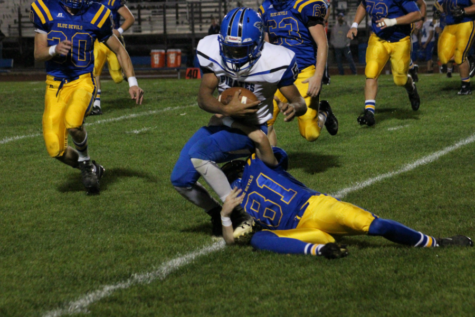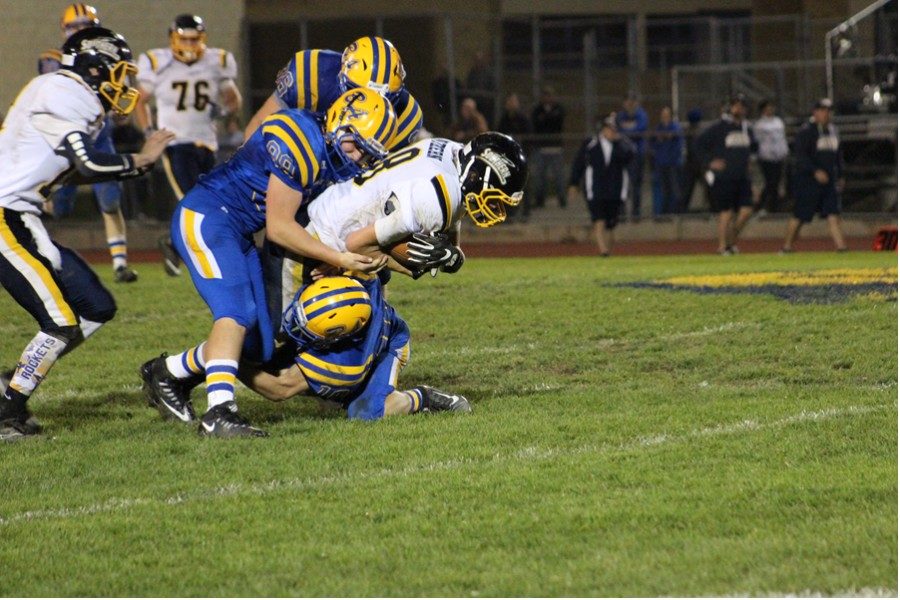Hard-hitting issues
B-A, like schools across the country, is addressing the way in which players tackle
November 3, 2017
The Blue Devils football team has adopted a tackling philosophy of going low and wrapping the legs in order to make the sport safer.
American football has always been a controversial force in our country. The sport, with its high rate of collisions and aggressive tendencies, has been a lightning-rod for criticism due to its often decimating injuries on the field.
A large part of that is due to the systems of tackling taught to players throughout their development.
The way players hit could be a danger to their health, and by using their head as another limb – one that they use quite unsparingly – many players have developed complications later in life.
At Bellwood-Antis, the football program has taken a stand against this methodology and in doing so made a rough sport a little safer.
Football’s dangerous history
Football in 2017 is played differently than in the past. Players are bigger, stronger and faster, and the equipment, including the helmet, has evolved to be much more protective. Studies studies are showing that this may not be as good a development as we once thought. One study from the Journal of the American Medical Association showed that 99% of former NFL players were posthumously diagnosed with CTE, a brain disease caused by repeated impacts to the head. In other words, people are dying much earlier because of football.
However it’s not the first time people have died due to collisions in football. Throughout the early 20th century, football proved to be as dangerous as today. In 1905, before there was a forward pass, and padding was an afterthought, about 20 people died from football alone. Though reports vary, it’s know many players were killed due to hemorrhaging in the brain. Newspapers of the day were divided, half supporting football, claiming a change in rules would be preposterous, and the other side fighting to make the sport safer.
In central Pennsylvania, too, there has been debate over football’s safety. In 1897, in a precursor to the Backyard Brawl, the annual rivalry football game between Tyrone and Bellwood-Antis, a player representing Tyrone was killed because of a tackle from a player on the Bellwood side. After this, along with backlash from the community, high school football was banned for nearly 25 years in the borough of Tyrone.
Does it work?
Coach Hayes has seen much change in his extensive career as Bellwood-Antis’ head coach. He’s seen the introduction and utilization of video analysis in the game, as well as countless other innovations in equipment and the way his players don it, but this style of tackling, perhaps surprisingly, is not new to the coach.

Low, rugby-style tackling has become the emphasis at B-A in order to promote safety.
“It’s actually going back to the way of tackling many years ago when the shoulder was the primary force, but with the advancement of helmets and faceguards and things like that, it became far more advantageous or desirable to get the head involved and consequently, we’ve found the results of that have been a little more dangerous than what they may have thought originally,” Hayes reflected.
The other Blue Devil coaches backed Hayes in his support of the style, but also brought up the very real challenge of retraining players in using the tackle.
“Sometimes it’s hard because you have to break habits of people who’ve done the same thing all their life, but we’re trying to make it a bit safer, which is a good thing,” explained Lovrich.
Hayes also realizes this, along with the sometimes dangerous split-second decisions needed in a game like football.
“You have to understand that when you get into an instantaneous situation you often rely and do whatever you can, and often times that’s a revert back to the habits you have,” he said. “We’ve seen players that have used it, and it’s very sound, but by the same token it’s not 100 percent used right now and probably never will be.”
It’s still a process to train players to give up natural instincts but it absolutely has effected the way players tackle. Take Eric Morder, for example. The linebacker claimed that his tackling style has been affected by the training the team took on the past three years.
“In open field – instead of reaching and grabbing – I break down and put a shoulder into them; it allows me to make the tackle effectively every time,” Morder assured.
Pullara, also understands that players won’t always properly tackle, but overall, he believes football is safe for children to play ins pite of declining participation numbers.
“I would say there’s concern, but there’s always concern in anything you do in sport, you do something wrong and get injured no matter what sport or activity you do, but if you’re doing the proper techniques, they’re taught to keep you safe,” said Pullara.
“I’ll let my kid play,” he concluded simply.
